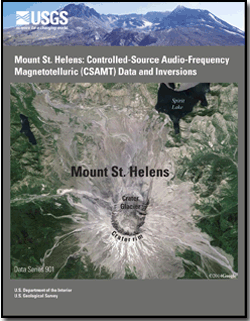 Introduction Introduction
This report describes a series of geoelectrical soundings carried out on and near Mount St. Helens volcano, Washington, in 2010–2011. These soundings used a controlled-source audio-frequency magnetotelluric (CSAMT) approach (Zonge and Hughes, 1991; Simpson and Bahr, 2005). We chose CSAMT for logistical reasons: It can be deployed by helicopter, has an effective depth of penetration of as much as 1 kilometer, and requires less wire than a Schlumberger sounding.
This Data Series provides the edited data for these CSAMT soundings as well as several different types of 1-D inversions (where the signal data are converted to conductivity-versus-depth models). In addition, we include a map showing station locations on and around the volcano and the Pumice Plain to the north.
The apparent conductivity (or its inverse, apparent resistivity) measured by a geoelectrical system is caused by several factors. The most important of these are water-filled rock porosity and the presence of water-filled fractures; however, rock type and minerals (for instance, sulfides and clay content) also contribute to apparent conductivity. In situations with little recharge (for instance, in arid regions), variations in ionic content of water occupying pore space and fractures sampled by the measurement system must also be factored in (Wynn, 2006). Variations in ionic content may also be present in hydrothermal fluids surrounding volcanoes in wet regions. In unusual cases, temperature may also affect apparent conductivity (Keller, 1989; Palacky, 1989). There is relatively little hydrothermal alteration (and thus fewer clay minerals that might add to the apparent conductivity) in the eruptive products of Mount St. Helens (Reid and others, 2010), so conductors observed in the Fischer, Occam, and Marquardt inversion results later in this report are thus believed to map zones with significant water content. Geoelectrical surveys thus have the potential to reveal subsurface regions with significant groundwater content, including perched and regional aquifers. Reid and others (2001) and Reid (2004) have suggested that groundwater involvement may figure in both the scale and the character of some if not all volcanic edifice collapse events. Ongoing research by the U.S. Geological Survey (USGS) and others aims to better understand the contribution of groundwater to both edifice pore pressure and rock alteration as well as its direct influence on eruption processes by violent interaction with magma (Schmincke, 1998).
|
First posted January 27, 2015
This report is online only
Part or all of this report is presented in Portable Document Format (PDF). For best results viewing and printing PDF documents, it is recommended that you download the documents to your computer and open them with Adobe Reader. PDF documents opened from your browser may not display or print as intended. Download the latest version of Adobe Reader, free of charge.
|